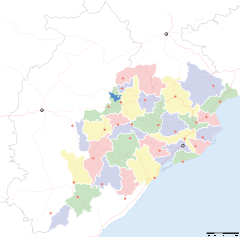- Mangalesvara Siva Temple
-
Mangalesvara Siva Temple 
Coordinates: 20°14′38″N 85°50′38″E / 20.24389°N 85.84389°ECoordinates: 20°14′38″N 85°50′38″E / 20.24389°N 85.84389°E Location Country: India State: Orissa Location: Bhubaneswar Architecture and culture Primary deity: lord Siva Architectural styles: Kalingan Style (Kalinga Architecture) History Date built:
(Current structure)14th century A.D. Mangalesvara Siva Temple is a Hindu temple located in Bhubaneswar, Orissa, India. It is located at Lat- 20◦ 14’ 38” N., Long- 85◦ 50’ 38” E., and at a elevation of 45 ft.
Contents
Location
The Mangalesvara Siva Temple is located in the precinct of Papanasini tank and on the southern embankment of the tank. The temple is facing towards east and the enshrined deity is a circular yonipitha.The Lingam is absent. The temple is 1.60 metres below the present road level.
Various cultural functions like Sankranti, Sivaratri and Jalabhiseka are performed.
History
It is a public property. Taranisen Batu is the priest of this temple. Architectural features suggest that this temple was built in 14th century AD.
Architecture
It is a Precinct and the typology is rekha and pidha. Earlier it was used for worshipping but now it is a living temple.
It is surrounded by Papanasini tank in north at a distance 6.70 metres, the compound wall of Papnasini tank in west and south and a shop in east.
Orientation: The temple is facing towards east
Architectural features (Plan and Elevation): On plan, the temple has a square vimana measuring 3.30 square metres and a square jagamohana measuring 4.50 square metres. The ganthiala measures 0.40 metres in length. The sanctum of vimana measures 1.20 square metres and that of jagamohana measures 2.50 square metres. On elevation, the vimana is of rekha order that measures 8.14 metres in height form pabhaga to mastak. The temple has a bada gandi and mastaka. With fivefold divisions of the bada of the vimana it measures 2.44 metres.At the bottom the pabhaga has five base mouldings of khura, kumbha, pata, kani and basanta that measures 0.61 metres in height, talajangha measures 0.45 metres, bandhana 0.21 metres, upara jangha 0.58 metres and baranda measures 0.59 metres. The gandi of the vimana measures 3.70 metres in height with a central raha and a pairs of anuratha and kanika pagas are either sides of raha.The mastaka of the vimana measures 2.00 metres in height. The bada of the jagamohana also has fivefold divisions measuring 2.20 metres in height. Pabhaga has five base mouldings of khura, kumbha, pata, kani and basanta measuring 0.57 metres in height, talajangha 0.53 metres, bandhana 0.13 metres, upara jangha 0.52 metres and baranda 0.45 metres. Gandi and mastaka of jagamohana measures 1.60 metres and 1.85 metres respectively. While the vimana has a curvilinear spire, the jagamohana has a pyramidal gandi has two potalas separated by a recess kanthi. The lower potala has three tiers where as the upper potalahas two tiers. There are two balustrared windows in the bada of northern and southern walls of jagamohana.
Raha niche & parsva devatas: The parsvadevata niches are located on the raha paga of the talajangha on the three sides of north, west and south measure 0.60 metres in height x 0.30 metres in width x 0.15 metres in depth. All are empty.
Decorative features
The doorjambs of vimana has three plain vertical bands that measures 1.60 metres in height x 1.28 metres in width. At the base of the doorjambs there are dvarapala niches with pidhamundis measures 0.22 metres in height x 0.11 metres in width holds tridents. At the lalatbimba Laxmi is in Padmasana holding lotus in her both hands.The doorjamb of Jagamohana measures 1.63 metres x 1.12 metres. It has three plain vertical bands in each side and at the base of the doorjamb there are Saivite dvarapalas. The dvarapala niches measuring 0.20 metres in height x 0.10 metres in width. The dvarapalas hold trident in their left hand and their right hand is in varada mudra. At the lalatabimba Laxmi isseated in Padmasana and the deity holds lotus in her both hands.
Lintel: On the architrave above the doorjambs is carved with navagraha panel in which Ravi is holding lotus in his hands, Rahu holding bow or half moon in his both hands and Ketu with a serpent tail.
- Building material: Laterite.
- Construction techniques: Dry masonry
- Style: Kalingan
Conservation
State of preservation: It is fair due to the recent conservation work.
Condition description: Signs of distress: Growth of vegetation over the monument. Repairs and Maintenance: It was repaired by Orissa State Archaeology under X and XI Finance Commission Award.
Threats to the property: Conservation Problem and Remedies: Creepers and wild grasses are found in all sides of the exterior wall of the vimana and jagamohana. Besides lichens covered these two stuctures.
See Also
- List of temples in Bhubaneswar
References
- Dr. Sadasiba Pradhan & Team, Dated on 15.11.2006,Debala Mitra, ‘Bhubaneswar’ New Delhi, 1958, P. 29.
- K.C. Panigrahi, Archaeological Remains at Bhubaneswar, Calcutta, 1961. PP. 16–17 and 25.
- L. S.S. O’ Malley, Bengal District Gazetteer Puri, Calcutta 1908, P. 240.
- M.M. Ganguly, Orissa and Her remains, Calcutta, 1912, PP. 393–394.
- P.R. Ramachandra Rao, Bhubaneswar Kalinga Temple Architecture, Hyderabad, 1980, P. 29.
- R.P. Mohapatra, ‘Archaeology in Orissa’. Vol. I, Delhi, 1986. P. 57.
- R.L. Mitra. The Antiauities of Orissa, Vol.II, Calcutta, 1963, PP. 160–161.
- T.E. Donaldson, ‘Hindu Temple Art of Orissa’. Vol. I, Leiden, 1985, P. 76.
External links
Categories:- Hindu temples in Bhubaneswar
Wikimedia Foundation. 2010.

